AAC in School: Classroom Communication Goals Grid – Revised
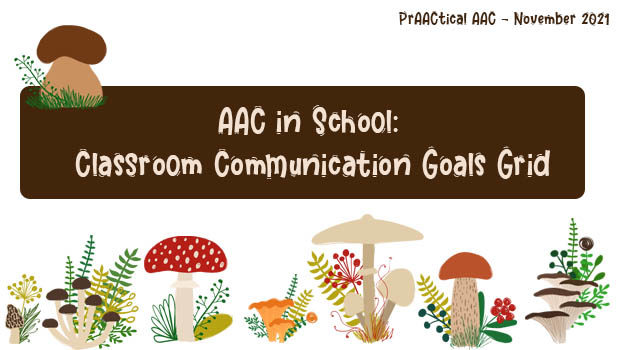
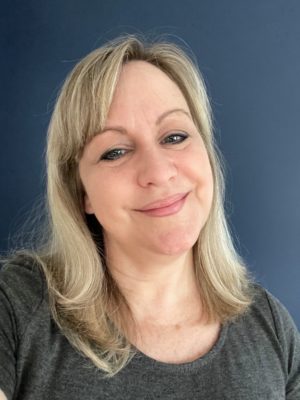
AAC SLP Vicki Clarke is known to long-time readers for her excellent series, AAC Assessment Corner, and her collaboration with Holly Schneider in creating the Dynamic AAC Goals Grid (DAGG-2). Today, we welcome her back to tell us about the revised version of her goal-setting guide designed especially for school settings.
Join us in learning about the Classroom Communication Goals Grid and download a free copy.
Classroom Communication Goals Grid- Revised
https://www.teacherspayteachers.com/Product/AAC-Classroom-Communication-Project-2021-Intro-and-Tools-4219461
It’s been over 5 years since I developed the Classroom Communication Goals Grid. During that time it’s been in use in many of our districts helping teachers and therapists assess the communication skills of their students, select goals relevant to the academic environment, and show progress at annual IEP time. The Grid needed some revision, a little more review of current research, a little reorganization of goals, and a facelift! This article is to introduce you to the next iteration! I wanted to talk to you about the origin, purpose, components, and use of the Classroom Communication Goals Grid-Revised, to help you develop IEP goals for communication.
In order to develop appropriate communication objectives for the IEP, we have to first describe what communicative competence looks like in the academic environment. In 1940 Maslow described a hierarchy of needs that all humans must fulfill in order to reach their potential. He described five areas of need including physiological needs for our bodies, such as eating drinking, sleeping, and breathing; needs to be safe and secure financially, having a place to live and overall health; to experience love and belonging through social relationships; to develop confidence and self-esteem; and finally to reach self-actualization, to be able to learn, problem-solve, be creative, empathetic and moral.
These are the basis for the 5 areas of competence you will find on the Classroom Communication Goals Grid including communicating to meet wants and needs, social exchanges, information exchange, language development, and academic access. These areas are developed around the communication components necessary to begin to meet these overall human needs.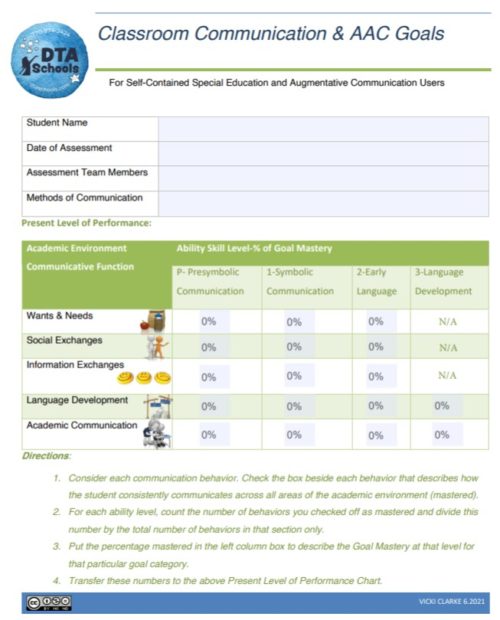
We all know as educators that we have to address academics in the classroom, but why are we talking about simple communication skills? Why is this something that is required to be addressed on the IEP?
Kathard and Pillay (2015) explain this eloquently, “communication is central to classroom learning because it is the medium through which instruction takes place, meaning is generated, and knowledge and skills are shared and demonstrated. “
In his study of second language learning, Jim Cummings developed a concept he called BICS and CALP. He discusses that students must learn basic interpersonal communication skills (BICS) first before they can begin to use those language and communication skills for academics (cognitive academic language proficiency- CALP). When a student comes to a country that speaks a different language, it takes them between six months and two years to begin to communicate basic social messages effectively. Once these skills are mastered, students are able to move on to using these language skills to develop higher-level cognitive academic skills. Imagine that you move to Mexico with the intent of attending and graduating from the University. If you were not a fluent Spanish speaker, the first thing you must do is learn to interact in Spanish. Can you imagine if the first thing that you had to do upon arriving in Mexico was to attend and participate in an algebra class? When we asked her students to learn academics without an ability to even communicate socially or providing them the same challenge.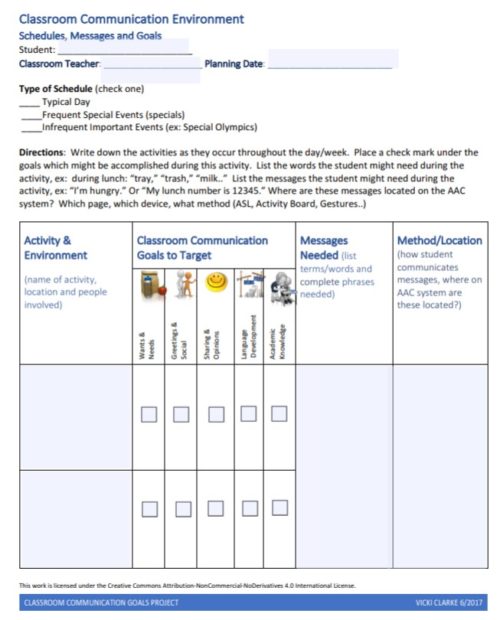
Basic interpersonal communication skills mean “cognitively undemanding language that’s easy to understand, deals with everyday language and occurrences, and uses simple language structures. “On the communication goals grid, this includes skills in four areas, wants and needs, social exchanges, sharing comments opinions and information, and language development. Cognitive academic language is cognitively demanding language relating to abstract concepts with specialized vocabulary and using more complex language structure. On the classroom communication goals read you’ll find these goals embedded in the language development and academic access areas.
Why is it not OK to simply stand in front of a classroom and simply give students information? Why do we want students to communicate effectively in the classroom? We’ve learned that active involvement helps students reinforce important material concepts and skil0ls it provides more frequent and immediate feedback to the students. Students learn more quickly when they can connect new learning to their previous knowledge which increases their motivation. Finally, active engagement builds self-esteem in conversations with other students.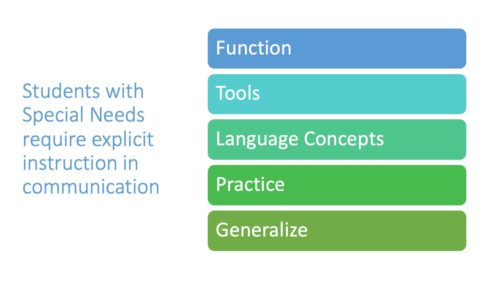
Students with special needs require explicit instruction in communication. These are students that come to us without having acquired age-appropriate typical language and communication skills. So the first thing that we have to do is help them learn to communicate before we can expect them to be able to communicate for the purpose of learning. They have to learn the purpose of communication, how to communicate which can mean speech, appropriate gestures, and use of their AC system. They had to learn concepts around language vocabulary and how we put words together to form understandable messages. They have to practice the skills and then generalize them throughout the day. It’s not good enough to be able to respond to ”What is the weather, or day, or month?” if you cannot say “Hi” to a friend, tell your teacher you need to use the restroom, request your favorite leisure activity or share your opinion.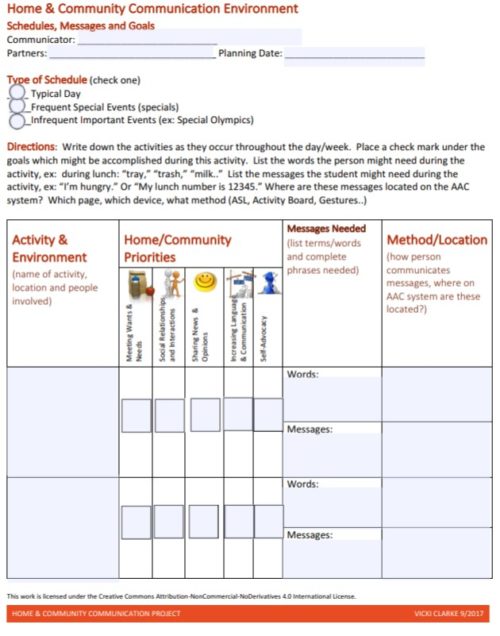
On the classroom communication goals grid, you’ll find a grid for all five areas, wants and needs, social exchanges, information exchange, language development, and academic access.
Each grid will have a list of expected communication behaviors in a simple hierarchical order. The behaviors that you find on the Classroom Communication Goals Grid-R are determined from language development research, standardized assessments, and industry-wide accepted banks of goals.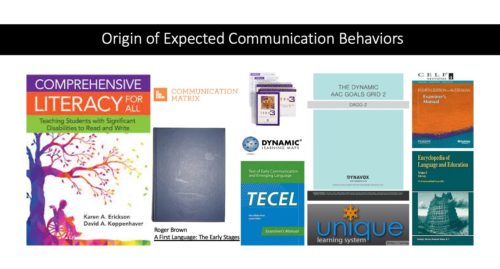
The goals are grouped by ability level beginning with pre-symbolic communication, moving to symbolic communication, then early language followed by language development. Presymbolic communicators are those who are communicating through gestures facial expressions and discrete motor movements. They are not using spoken words or individual symbols to communicate. Symbolic communicators have learned that one symbol can mean one item. For example, a spoken word such as apple means that round red crunchy fruit that I like to eat. That drawing of a laughing face means “like.” At the early language development stage students are beginning to take those single words and put them together to create novel messages. They’re developing slightly more abstract language and will vocabulary. By Stage 4, students are learning to use their language creatively with appropriate word order, vocabulary, and for appropriate purposes.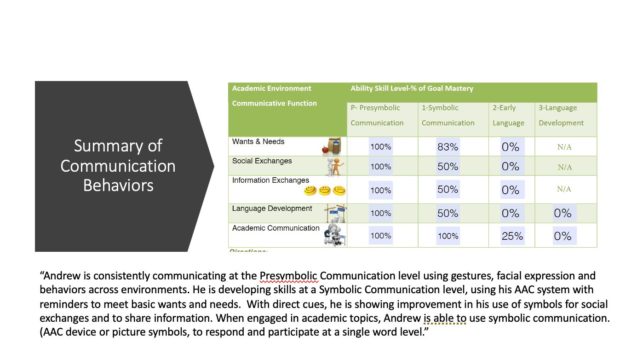
The summary chart will allow you to generate your present level of performance statement by describing the students’ overall level and giving specific examples from the completed goals grid.
“Andrew is consistently communicating at the pre-symbolic communication level using gestures facial expression behaviors across environments. He’s developing skills at a symbolic communication level, using his AAC system with reminders to meet basic wants and needs. With direct cues, he’s showing improvement in his use of symbols for social exchanges and to share information. When engaged in academic topics, Andrew is able to use symbolic communication, such as his AAC device or picture symbols, to respond to participate in a single word level.”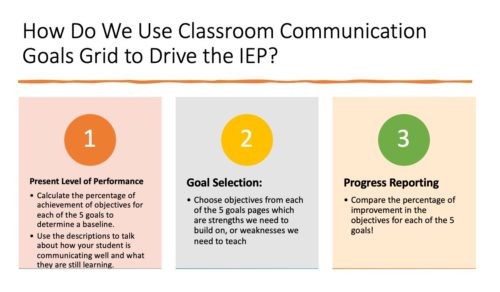
So how do we use the classroom communication goals grade to drive the IEP? Once we have completed the goals grid are able to make a statement regarding the student’s present level of performance on communication. We can use the student’s achievement and challenges documented in the goals grid to help determine objectives from each of the five areas to build on. And finally, we can re-administer the Goals Grid for subsequent IEP’s to show progress through an increase in the percentage of improvement in the objectives for each of the five goals.
My hope is that this will be another tool for your classroom communication toolbox, to help you identify skills and needs to better plan for communication implementation.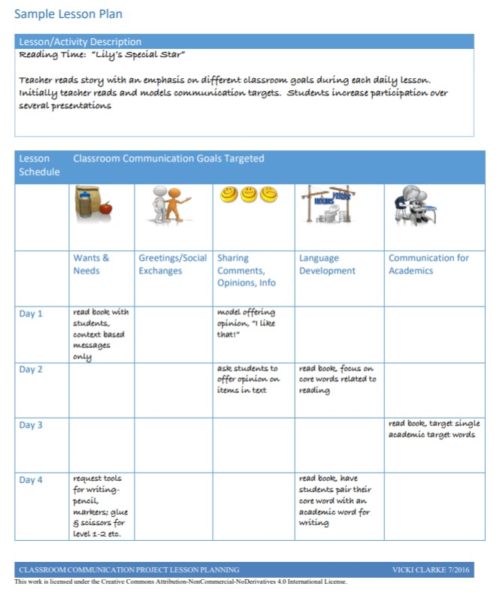
You can check out Vicki’s video overview, as well.
Direct Link to Video – https://www.youtube.com/watch?v=4lMP6CV0PVk&ab_channel=VickiClarke%26AACChicksatDTASchools
About the Guest Author
Vicki Clarke is the CEO of Dynamic Therapy Associates, Inc (DTA Inc.), a speech-language pathology clinic specializing in AAC. She is the Director of DTA Schools, a division of DTA Inc, which provides individual student, classroom, and district-wide AAC services for consultation, assessment, training, curriculum development, and equipment procurement in multiple public school districts. Additional professional activities include professional consultation and training through publications, workshops, and presentations at local, state, and national conferences in the areas of augmentative communication, speech-language pathology, special education, and autism.
DISCLOSURES: Mrs. Clarke is a co-owner of Dynamic Therapy Associates, offering private therapy, school-based contracts, and AAC-related products. Mrs. Clarke consults pro bono for various speech-generating device manufacturers, app developers (educational, AAC and speech pathology related). She regularly shares information and resources regarding special education, AAC, speech pathology and Autism on social media. In her capacity as an AAC evaluator and school district consultant, Mrs. Clarke is given access to professional copies of News-2-You products, almost all AAC apps, and long-term loans for speech generating devices from Tobii Dynavox, Prentke Romich, Saltillo, and Ablenet.
Filed under: Featured Posts, PrAACtical Thinking
This post was written by Carole Zangari
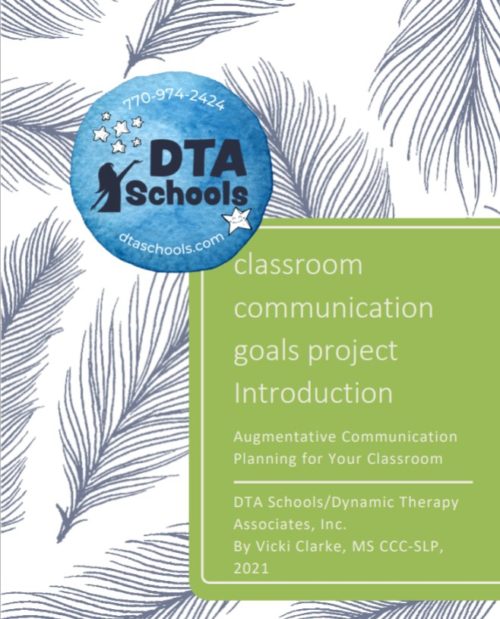

6 Comments
This is amazing!!! I am printing it and cannot wait to read and being using it with my nonverbal students who just started ACC.
Yay! I’m so pleased it will help you in your work!
I came on here to say the same thing, April. This is amazing. Thank you so much to Vicki Clarke for developing it and making it available for free, and thanks Carole for sharing it!
I’m excited to see so many people beginning to use it! We’ve been on a mission to end “eat, drink and potty” goals for 20 years. Hope this helps with that mission!
Thank you for this resource!!
You’re welcome!!